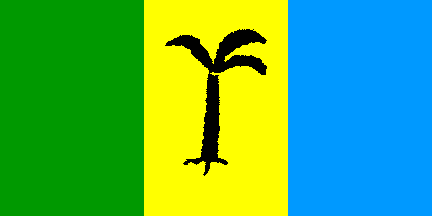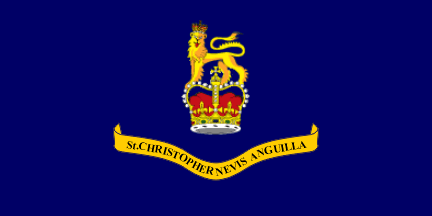
image by António Martins, 16 June 2002

Last modified: 2013-11-05 by zoltán horváth
Keywords: st. christopher nevis anguilla | saint kitts and nevis | saint christopher | nevis | anguilla | caribbean | palm tree | lion | crown | governor |
Links: FOTW homepage |
search |
disclaimer and copyright |
write us |
mirrors

image by António Martins, 16 June 2002
In 1967 the “triple palm” flag was introduced. Smith 1982
[smi82] shows undefaced
red ensign as ![]() , the palm flag as
, the palm flag as ![]() .
.
Željko Heimer, 01 Jan 2003
Here are details culled from the Encyclopædia Britannica: All three
islands were discovered by Columbus in 1493. He named the
principal island San Cristóbal after his patron
saint. The nearby island (3 km away) of Nevis
takes its name from "las nieves" (="the snows"), a reference to
Columbus’s observation of the cloud cap on the island peak.
San Cristóbal was officially named Saint Christopher by the
English (note: this was an English colony —
the English were very possessive about their colonies, even after the union of
the English and Scottish crowns), but the colonists who went to live there in
1623 almost immediately called it St Kitts. Both names were used.
A French settlement was also established on St Kitts in 1827. The
Treaty of Utrecht handed the island in its entirety to Britain in 1713. The
French invaded the island again in 1782, capturing Brimstone Hill, but were
expelled. Anguilla was named by the French because of its resemblance
to an eel ("anguille") — it is 25 km long, and nowhere wider
than 5 km. It became an English colony in 1650.
Reference to an atlas tells me that Anguilla lies some distance to the
north of St Kitts and Nevis, being separated by St Barthélemy and St
Martin/Sint Maarten, and is the northernmost island of any size to the east
of the Anegada Passage (Sombrero islet lies to the north, however).The three islands were joined in a single colony in 1882, but the name
Anguilla was initially not used in the colony’s name. It was called
either St Christopher and Nevis or St Kitts-Nevis.
The name St Christopher, Nevis and Anguilla (or St Kitts-Nevis and
Anguilla) was first used on postage stamps only in the late 1940s, when
the portrait of the grey-haired King George VI was introduced in place of the
previous younger portrait.
Mike Oettle, 05 Jan 2003
Flagwise, history starts with Leeward Islands
flags (blue enisgn, governor). These were used until, what? 1958?
Then there was West Indies with the blue wavy
flag 1958-1962.
Željko Heimer, 01 Jan 2003
The vertical tricolour with the palmtree
was adopted on 27 February 1967 when
St.Christopher (=St.Kitts) - Nevis - Anguilla
became an Associate State. The palm tree had
three branches, standing for the three islands.
On 12 July the same year Anguilla
seceded and declared its independence in 1969.
Mark Sensen, 26 October 1995
Why these three Caribbean flag, all from of 1967, are so similar?
Anticipating that St Vincent would become an Associated State the
College of Arms designed a new flag; green over yellow over blue with a
central badge of berries and leaves. They seem to have been trying to
create a family of flags for islands of the former
West Indian Federation.
David Prothero, 04 Aug 1999

image by Željko Heimer, 01 Jan 2003